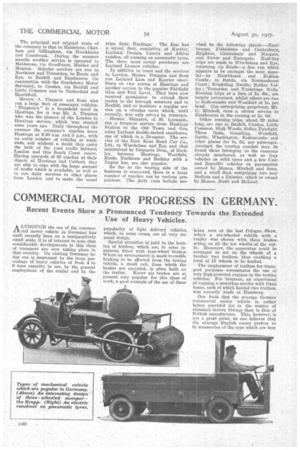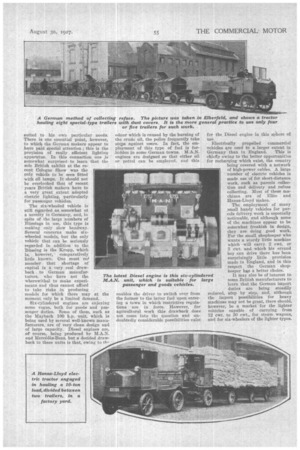COMMERCIAL MOTOR PROGRESS IN GERMANY.
Page 58

Page 59

If you've noticed an error in this article please click here to report it so we can fix it.
Recent Events Show a Pronounced Tendency Towards the Extended Use of Heavy Vehicles.
AA LTHOUGH the use of the commer-tidal motor vehicle in „Germany has until recently been on a comparatively small scale, it is of interest to note that considerable developments in this class of transport are now taking place in that country. On visiting Germany today one is impressed by the large percentage of heavy vehicles of from 4 to 6 tons capacity in use, by the general employment of the trailer and by the
popularity of light delivery vehicles, which, in some cases, are of very unusual design.
Special attention is'Paid to the braking of trailers, which are, in some instances, fitted with four-wheel brakes. Where no arrangement is made to enable braking to be effected from the towing vehicle, a small cab; from which the brakes are operated, is often built on. the trailer. Knorr air brakes are at ,present very popular for this class of work, a good example of the use of these
being seen at the last Cologne Show, Where a six-wheeled vehicle with a trailer was shown with these brakes acting on all the ten wheCls of the outfit. Moreover, the apparatus could be Arranged to 'act on the wheels of a further two trailers, thus enabling a total of 18 wheels to be braked.
The employment of trailers for transport purposes necessitates the use of very high-powered engines in the towing vehicles.For instance, an experiment of running a motorbus service with Daag buses, each of which hauled two trailers, was recently made at Hamburg.
One finds that the average German conimercial motor vehicle is rather better provided for in the matter of standard luxury fittings than is that of British manufacture. This, however, is not a great point, as one believes that the average English owner prefers to lit accessories of the type which are bcst suited to his own particular needs. There is one essential point, however, to which the German makers appear to have paid special attention ; this is the provision of really efficient lighting apparatus. In this connection one is somewhat surprised to learn that the sole British exhibit at the recent Cologne Show was the only vehicle to be seen fitted with oil lamps. It should not be overlooked that of recent years British makers have to a very great extent adopted electric lighting, particularly for passenger vehicles.
The six-wheeled vehicle is still regarded as somewhat of a novelty in Germany, and, in spite of the large numbers of Bfissings in use, this type is making only slow headway. Several concerns make sixwheeled models, but the only vehicle that can be seriously regarded in addition to the Bussing is the Krupp, which is, however, comparatively little known. One must re? member that shortage of capital is a very real drals back to German manufacturers, who have not the wherewithal to make experiments and thus cannot afford to take risks in producing models for which there may at the moment only be a limited demand.
Six-cylindered engines are enjoying some vogue, both for goods and passenger duties. Some of them, such as the Maybach 100 h.p. unit, which is being used by several well-known manufacturers, are of very clean design and of large capacity. Diesel engines are, of course, being produced by M.A.N. and Mercedes-Benz, but a decided drawback to these units is that, owing to tie odour which is caused by the burning of the crude oil, the police frequently take steps against users. In fact, the employment of this type of fuel is forbidden in some German towns. M.A.N. engines are designed so that either oil or petrol can be employed, and this
enables the driver to switch over from the former to the latter fuel upon entering a town in which restrictive regulations are in force. However, for agricultural work this drawback does not come into the question and undoubtedly considerable possibilities exist for the Diesel engine in this sphere of use.
Electrically propelled commercial vehicles are used to a larger extent in Germany than in England. This is chiefly owing to the better opportunities for recharging which exist, the country being covered with a network of high-power cables. A large number of electric vehicles is made use of for short-distance work, such as parcels collection and delivery and refuse collecting. Most of these machines are of Elite and Hansa-Lloyd makes.
The employment of many small handy vehicles for par'eels delivery work is especially noticeable, and although some of the machines appear to be somewhat freakish in design, they are doing good work. For the small shopkeeper who wants a sturdy little machine which -will carry. 2 cwt. or 3 cwt. and which his errand boy can drive there has been surprisingly little provision made in England, and in this respect the German shopkeeper has a better choice.
It may also be of interest to some British manufacturers to learn that the German import duties are being steadily reduced, step by step, and, although the import possibilities for heavy machines may not be great, there should, however, be a market for the lighter vehicles capable of carrying from 12 cwt. to ao cwt., for steam wagons, and for six-wheelers of the lighter types.




































































































